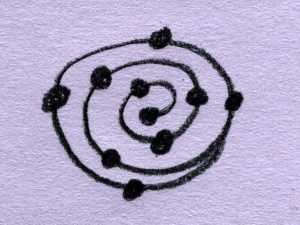
Arrived in Tasmania Jan 15. Moved all artwork from Talbot Rd studio. Photographed and catalogued over 300 works for archiving and future animating: changing colours of Mount Arthur painted in early mornings throughout a year, drawings of trees and other growing things, animals (including people) going about their day-to-day business.
Attended Linux conference in Hobart, 20th-23rd. Particularly interesting keynote speech on peer to peer rather than hub and spoke structures for knowledge exchange in the development of open source software. I saw parallels in the sciences and potentially in the arts.
Met with more scientists at the Australian Antarctic Division (AAD) and was offered data to animate some new research: embryonic krill tolerance to increasing levels of C02 in Southern Ocean, humpback whale migrations from Eden, speciations of octopi during interglacial periods.
Within the AAD is evidence of Antarctic animation.
Attending a talk about the latest satellite mapping of Macquarie Island, I see an animation drawn from some of that data, combined with digital photos taken at ground level. This combination gives a sense of human connection with the place, and with the mechanical satallite ‘eye’.
Dave Watt, in AAD’s data Resource Centre, showed me examples of Antarctic animations drawn from data collected by satellites. Overlays of these suggest connections between the different kinds of data. This suggested overlaying objective and subjective Antarctic animations.
Graeme Watts from the AAD Library, showed me designs by Knowles Kerry for a past SCAR conference: drawings on corner pages of notes make a flip-book animation of a waddling penguin, an Escher-like pattern on the conference bag suggests ice melting.
Saw, through a microscope camera, a krill embryo emerging. The motion of its legs was that of its adult form – fast and relentless.
Observed and drew live adult krill swimming in tanks, and saw the plankton farm that feeds them.
Revisited the AAD’s Antarctic art collection, including Fred Elliott’s ‘Antarctic in Black and White’ and Stephen Eastaugh’s assemblages.
Visited the Tasmanian Museum and Art Gallery (TMAG) Antarctic display and saw Peter Morse’s 3D film. Noticed that he arranged his sequences into categories similar to mine: (from memory, not in order…) Water, Glacier, Horizon, Life)…elemental. Screened in a booth separated from the clutter of surrounding displays, the film worked well to imaginatively transport me to Antarctica. Like my ‘Life’ animations, Morse’s ‘Life’ sequence includes humans and evidence of us on the place.
Immersed my eyes in Jorg Schmeisser’s huge Antarctic landscapes.
Visited an exhibition, ‘The Leonardo Da Vinci Machines’ that provided a good example of a bad way to present material to the public. It was visually and acoustically confusing and the models were rough and did not work. However, it did remind me of ways Leonardo thought that have timeless value: his metaphor of the human form reflecting the earth itself, with rivers like veins of blood making energetic connections.
Sunday 25th-Wednesday 29th walked from the top end through the Douglas Apsley National Park, north east Tasmania, and to Bicheno.
Bus to Triabunna and ferry to Maria Island, camping and walking two nights. Extremely hot weather. Found lots of animal life, including humans, to draw for animating. Gathered sound recordings of early morning birds.
Observed and made rubbings of fossils: evidence of Gondwanan life.
Swam in the rock pools by the Painted Cliffs.
Returning from Maria Island, waiting for the bus to Hobart, I met a French man returing from two months in Antarctica. Maria Island had provided an interlude between the ice and home. There is ‘nothing’ to see, he said, on the Antarctic ice plateau. An astrophysicist working on Dome C, he assessed the conditions necessary for building a telescope there, to study the stars and our sun’s activities. Antarctica, he said, was ‘the closest place to being in space’, he said.
Staying at the New Town YHA in Hobart, I find two books in the Recreation room, one on arts and another on sciences.
Edmund Wilson’s book, Axel’s Castle, first published in 1931and republished by Fontana in 1959, surveys Symbolism, including essays on the poetry of W. B. Yeats, James Joyce and Gertrude Stein. Wilson says things about metaphors that I will ponder further upon…
The Symbolists themselves, full of the idea of of producing with poetry effects like those of music, tended to think of these images as possessing an abstract value like musical notes and chords. But the words of our speech are not musical notation, and what the symbols of Symbolism really were, were metaphors detached from their subjects – for one cannot, beyond a certain point, in poetry, merely enjoy colour and sound for their own sake: one has to guess what the images are being applied to. And Symbolism may be defined as an attempt by carefully studied means – a complicated association of ideas represented by a medley of metaphors – to communicate unique personal feelings. (p. 24)
For Fred Elliott, Beethoven’s 5th Symphony was a metaphor for his experience of Heard Island.
Yeats suggests a lack of line between our art and life:
O chestnut tree, great rooted blossomer,
Are you the leaf, the blossom or the bole?
O body swayed to music, O brightening glance,
How can we know the dancer from the dance?
A slim 1957 Penguin publication, Science News 45, includes various scientific reports, with one on the 1957-8 International Geophysical Year (IGY). Drawings of Auroras in Antarctica, made with simple lines, suggest ways to animate these elusive changing forms.

Aha!